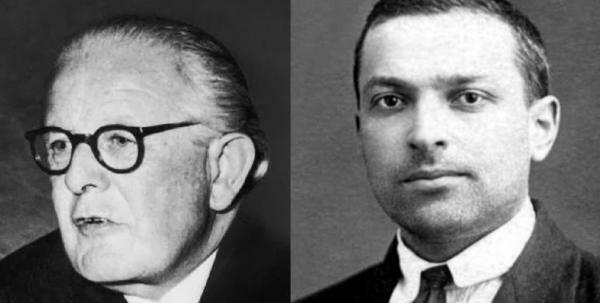
Piaget and Vygotsky were two researchers interested in teaching. Both contributed to research on children's learning and cognitive development, creating theories that have marked the world of education from then until the present.
Thus, from Psychology-Online, we want to give you the opportunity to learn about the two most recognized learning theories, as well as their similarities and differences. To do this, do not hesitate to continue reading this article about Piaget vs Vygotsky: differences and similarities between his theories.
Piaget studied the children's cognitive developmentof him, based on his constructivist theory, in which it is understood that children build their own learning through active contact with what they already know and interpreting new facts and / or objects. In other words, Piaget studied the cognitive development of people by focusing on the way in which new knowledge is acquired as people develop.
For this reason, Piaget divided the cognitive development of children into 4 major stages:
- Sensorimotor (0-2 years)
- Preoperational (2-7 years)
- Specific operations (7-11 years)
- Formal operations (+12 years)
At each of these stages, Piaget focused on paying attention to the change that occurs in children's qualitative thinking, as well as that each of these 4 stages is supposed to represent the gradual transition from a more complex and abstract way of obtaining knowledge.
According to Piaget, children progress as they gradually go through these 4 stages. At the beginning of these stages, children's language and thinking cannot be changed, since both appear throughout the development of these stages and are formed along with the behaviors symbolic.
You can expand this information by consulting the article Piaget's Theory of Learning.
In the Vygotsky's sociocultural theory, how children learn as they develop was studied. However, when it comes to giving importance to the relationship between the child and her interaction with objects and the environment that surrounds her, Vygotsky lends more importance to a third person, that is, from Vygotsky's theory it is considered that for children to develop their learning, it is fundamental the participation of a third individual, on which all the importance rests. In other words, without this third individual, the children's relationship with their environment and the development of their learning would not be possible or it would be more complicated.
It should be noted that Vygotsky considered that in order to carry out a study on the development of children, it is essential to carry it out in real and natural contexts such as, for example, at school, at home or in family situations, with friends, among others. Conversely, conducting studies in artificial spaces (doctor's office, office, laboratory ...) could lead to a lower reliability of the study. In addition, Vygotsky also emphasizes that children mature and develop depending on what they are going learning, regardless of age, and with the help and support of other individuals with more capabilities.
According to Vygotsky, they should be taken into account 3 levels when carrying out these studies:
- Immediate interactive level
- Structural level
- Cultural level (way we communicate)
According to Vygotsky, we are capable of communicating through social language from the moment we are born and, as time progresses, we strengthen the internalized language.
You can keep getting informed by consulting the article Lev Vygotsky and the roots of language.
After knowing briefly the theories of Piaget and Vygotsky, we present the main similarities that are detected between these theories:
- Interests: The main similarity that we find refers to the fact that both Piaget and Vygotsky share a great interest in studying the cognitive development of people from the moment they are born.
- Constant Learning: the theories of both researchers understand that people's learning never ceases, since people's development allows them to continue learning. In this way, learning never comes to an end, since people live in constant development.
- Constructivism: both researchers propose their theories from a constructivist paradigm. From constructivism, it is understood that for the learning process it is essential that the subjects are participatory, dynamic and interactive. For this reason, they consider that social interaction (with the environment and with the people and objects that surround them) encourages and it favors the learning of the people although, next, we will see a small difference regarding the interaction.

Do you want to know the main differences between the theories of Piaget and Vygotsky? We present them below:
1. Individual action vs interaction
As we have mentioned previously, both researchers consider that social interaction favors the development of people. However, within this similarity we find a difference:
- On the one hand, Piaget consider that children can learn from autonomous way, without the need to interact, although the interaction may favor it.
- On the other hand, Vygotsky believes that in order to learn, children need the interaction with other people.
Thus, Piaget gives more importance to individual actions, understanding the interactions social variables as variables that influence learning, on the other hand, Vygotsky gives more importance to the interaction.
2. Language
Language is another difference between the theories of Piaget and Vygotsky:
- Vygotsky He considers that language exists from the moment we are born, referring to this language as the social language, which allows us to interact with the environment in order to express ourselves (for example, when we cry we communicate). As time passes, according to Vygotsky, we begin to develop internalized language, that that allows us to think with words and express in a more developed way what we want explain.
- Contrary, Piaget considers that children, at first, develop a egocentric languageIn other words, with this language, children are not able to perceive things from a point of view other than their own, thus making social interaction difficult. Thus, according to Piaget, as time passes, children develop social language.
3. Age
- On the one hand, Piaget considers that children learn certain ages already established, divided into the 4 stages already mentioned.
- On the other hand, according to Vygotsky, children mature based on what they learn, regardless of your age.
That is, for Piaget age conditions learning and for Vygotsky it is learning that conditions maturity.
4. Learning type
- In order to Piaget, the type of learning that children use to develop their intelligence is the Learning by discovery, that is, that learning in which children take a more active and experimental role, without the need to maintain contact with other people.
- On the contrary, for Vygotsky, the type of learning that children use as they develop is the Collaborative learning, which requires social interactions both with the environment and with the people around them.
This article is merely informative, in Psychology-Online we do not have the power to make a diagnosis or recommend a treatment. We invite you to go to a psychologist to treat your particular case.


